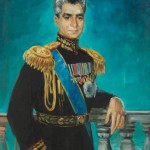In 1947, Alejo chooses to live in Paris in order to refine his talent. He travels across Europe by car, visits its museums and monuments, gathering inspiration from the great masters he admires. One year later, Tilda Thamar joins him in Paris.
In 1949, he holds his first exhibition in Paris; critically well received, it features a variety of works – portraits, still lifes, landscapes, and cities. It’s a productive period, pushed by his wife’s inspiration and intense social life in postwar Paris.
In 1956 Alejo’s reputation blossoms when the Countess of Paris commissions twelve portraits – one of herself and one of each of her eleven children. Marie-Charlotte Pedrazzini, journalist at Paris-Match Magazine, writes an article about this commission thus boosting Alejo’s international career. They would get married 21 years later.
In his Montmartre studio, Alejo welcomes many royals, including Italy’s King Umberto and his daughters; Wallis, Duchess of Windsor; Princess Grace and Prince Rainier of Monaco; as well as notables from the world of entertainment like Anouk Aimée, Audrey Hepburn, Sir Arthur Rubinstein, Maria Callas, Marilyn Monroe, Yul Brynner, and other personalities, including industrialist Gianni Agnelli, socialite Gloria Guinness, steel baron Hans Heinrich Thyssen-Bornemisza and shipping tycoon Aristotle Onassis’ family.
Commissions come in from all quarters – the imperial court of Iran and the royal families of Spain, Italy, Greece, Austria, Jordan and Yugoslavia, as well as the Grand Ducal Family of Luxembourg and the Princely Family of Monaco. In Brazil, Alejo paints four generations of a same family. In Argentina he paints several portraits of Amalia Lacroze and Alfredo Fortabat and their family – in exhibition at the Colección de Arte Amalia Lacroze de Fortabat.
Alejo Vidal-Quadras adopts a new, more streamlined, clean, and intimate style. He captures his models’ soul and personality.





